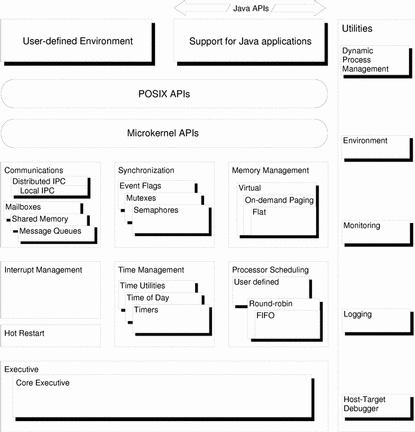Super-Configurability
Sun Embedded Workshop 4.0 uses a flexible, component-based architecture that allows different services to be configured into the runtime instance of the ChorusOS operating system.
Essential services required to support real-time applications running on the target system are provided by the core executive, and each optional feature of the operating system is implemented as a separate runtime component that can be added to or removed from the operating system, as required. This means that the operating system can be very accurately configured to meet the exact needs of a given application or environment, saving on memory and improving performance.
The core executive can support multiple, independent applications running in both user and supervisor memory space.
This flexible architecture is shown in Figure 1-1. Detailed descriptions of the optional features for the ChorusOS operating system are provided in "Operating System Components".
Figure 1-1 Component-based Operating System Architecture

By taking advantage of the component-based architecture, the application designer can choose between an extremely small operating system that offers simple scheduling and memory options, or a fully-featured, multi-API software platform.
As well as making it possible to produce multiple versions of the operating system, each of which is optimized for its own environment, the component-based architecture provides the following additional benefits:
-
Applications developed to run on a minimal configuration can also run unchanged on a more complex configuration, thus providing an evolutionary path for right-sizing devices and systems.
-
The programming interfaces for the operating system components are available publicly, providing an open environment for combining third-party system software and development tools.
- © 2010, Oracle Corporation and/or its affiliates
